- Continue Shopping
- Your Cart is Empty
"Chasing the Light" Featuring the Work of Romona Youngquist
Art Elements Gallery is excited to announce the opening of our latest show "Chasing the Light" which will feature the oil paintings of Oregon artist Romona Youngquist.
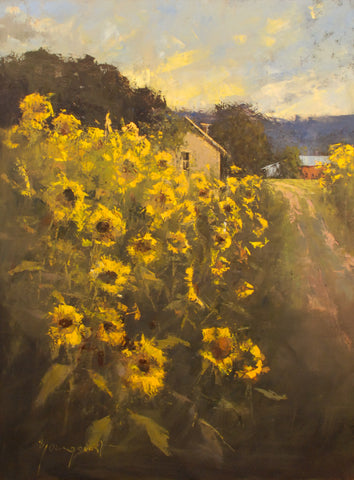
Romona Youngquist "Sunflower Sunset"
The spring and summer leading up to the show brought dramatic light that quickly became inspiration for her newest collection at ART Elements Gallery. Romona worked on capturing an abstract design of this incredible light in nearby coastal inland and of course, Oregon's Willamette Valley, the catalyst for so many of her paintings.
Romona Youngquist was born in 1960 in Yuba City, California, but grew up in Eastern Oklahoma. Romona essentially started out in life as a child of nature, spending her time exploring the woods with her dog and collecting critters. While exploring, she also studied the design and color of nature. Romona recalls many times standing in a field just staring in fascination at the values of the deciduous trees against a dark Oklahoma sky before a storm, and then rushing home to draw what she had seen. Technically self-taught, Romona thinks of nature as her real teacher. In 1994 she was awarded a grant from the Alaska State Council for the Arts to study with Oregon landscape painter Michael Gibbons and in the late 1990’s she studied with Michael Workman, a leading landscape painter from Utah. Romona has taken their valuable lessons and strengthened her own individual style. She also admires the work of Russell Chatham, Emil Carlson, and Wolfe Kahn, especially for their commitment to the beauty of simplicity and atmosphere. Her admiration of these painters has translated to numerous exhibitions and honors, awards and merits throughout the United States.
"My lifestyle hasn’t changed much since early childhood. I live on a little farm with my family in the middle of Oregon wine country; I still hang out in the woods with the dogs and my own kids; and I still collect a wide range of critters. When I’m not painting outside, I paint in my studio in order to keep an eye on my kids and pets, while listening to my favorite Bach, Handel, and Mozart."
"Chasing the Light" opened this past week and will run through September 30th.
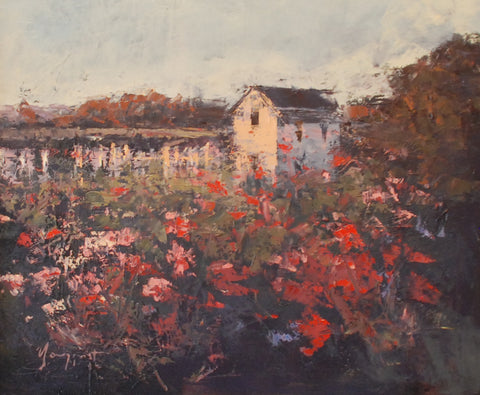
Romona Youngquist "Rosey Summer Glow"
"Clarity of Color" Featuring the Work of Marla Bagetta
Art Elements Gallery is excited to announce the opening of our latest show "Clarity of Color" which will feature the painting and pastel work of Oregon artist Marla Bagetta.

Marla Bagetta, "A Simple Surrender"
"Clarity of Color" opens June 23rd and will run through August 20th with an artist's reception June 23rd from 5-7
Marla Baggetta's approach to painting reflects the formal art education she received at Art Center College of Design and her experience as a landscape painter. A self-employed, professional artist since 1983, Marla had a distinguished career as a commercial illustrator before turning to landscape painting, working for clients such as Walt Disney, Nissan Motors, Houghton Mifflin Publishing, to name just a few. After moving to Oregon in 1993, she began painting the landscape and quickly established herself as one of the West's leading representational painters with her compelling and sophisticated imagery. She is a signature member of the Pastel Society of America and the Pastel Society of Oregon. Marla has won numerous awards for her paintings and has been featured in the premiere publication for pastel painters, Pastel Journal. Marla is also the author of Step by Step Pastel published by Walter Foster Publishing.
Marla say's of her work that...
I am a great believer in the fundamentals of painting; drawing, composition, color theory and the thought that paintings communicate an idea through this vocabulary. The process of bringing a concept to a complete image is deeply compelling and satisfying. My painting process is a very active one where my first marks and impressions are usually bold and gestural. Then I settle in and make assessments and refinements. The last marks are usually slow, quiet ones, as I am making small moves to find my way towards the finished piece. I'm hoping to capture the "aha!" that originally attracted me to my subject. Each one of my original pastels is done on museum grade sanded pastel paper. I use a variety of brands of soft pastel, each with different characteristics that I use to accomplish a variety of strokes and washes within a piece.

Marla working in her studio
We are thrilled to share this new body of work with you, and hope you will stop by the gallery this summer to see it in person!
A Technique of the Modern Age: The History of Plein Air Painting

Gustave Courbet, Bonjour Monsieur Courbet” (1854) Gustav Courbet depicts himself with all his painting gear in his pack, greeting friends on his way to paint out of doors. This is the most iconic representation of plein air painting.
The practice of painting en plein air (a french phrase that translates loosely to painting in “full” or “open” air) is a favorite pursuit of many of our landscape painters here at Art Elements. As this is a phrase we hear often around the gallery, I thought it might be fun to dig a little bit into the history of this particular painting tradition to learn a little more about it, and to see what gets our artists like Don Bishop, Romona Youngquist Mandy Main, Michael Orwick, and Molly Reeves so excited.

Art Elements artist Don Bishop, paints a lavender field en plein air

Art Elements Artist Romona Youngquist, Sunflower Farm, 6x8
As the phrase suggests, painting en plein air, essentially involves hauling one’s materials out to the remote location of your choice and painting directly from nature, rather than using a sketch, photograph or memory to reconstruct what was seen from within the confines of a studio. This was a favorite practice of French impressionist, like Claude Monet, Pierre- Aguste Renoir and Paul Cézanne.

John Singer Sargent, Claude Monet Painting by the Edge of a Wood (1885) now located at the Tate Gallery in London
For me, the notion of plein air painting conjures romantic images of the solitary and meditative artist at work in an entirely natural environment. There is something deeply organic and pure about this notion, as if this might be the way that painting originated.
Plein air painting is in fact, just the opposite, a modern invention, and one that is directly tied to the technological developments of the industrial era. Plein air painting might never have taken off had it not been for a simple modern invention.
In 1841 a man by the name of John Goffe Rand invented something simple, and revolutionary, the collapsible zinc paint tube with a stopper cap.

John Goffe’s patent drawings
Prior to this, paints were mixed in the studio by the individual artist, and once they were mixed they had to be carried in glass jars if they were to be transported anywhere. Considering the vast amount of colors and pigments that an oil painter might use to complete one work, the idea of packing up all of those glass jars and trekking out with them, sometimes many miles, to capture a desired scene, was basically impossible. But thanks to Mr. Goffes’s invention, artists were suddenly much more mobile! What’s more, paint could be mass produced and purchased by artists ready to use in the tube. I can’t help but this as the 19th century painters version of the i-phone, suddenly it’s a whole new world thanks to one little invention. Goffe’s pre-packaged paint tubes dramatically changed his customer’s relationship to their world and how they could depict it in their art.
Even thought when we think if plein air painting we often thing of the French impressionists, who popularized the practice, it actually began a generation earlier with the Romantics. English landscape artists John Constable and J.M.W. Turner were actually were actually some of the first artists to make names for themselves painting in this style. technique. Like our own Romona Youngquist, Constable loved to depicted pastoral imagery, often painting farm houses, barns or workers in their fields.

John Constable, The Haywain, 1821, now in the collection of the national gallery London. Constable predated the impressionists and was of the generation of Romnatic painters.
The barbazon school and the American Hudson River school of painters also took advantage of this opportunity prior to the impressionist co-opting of the practice.
So in fact, while we might tend to think of plein air painting as a return to nature, it would not have actually been possible if it were not for the technological advancements of the 19th century. And in fact, what these painters started a tradition of depicting not, unspoiled nature, but instead images of agriculture and industry, that our very on landscape painters continue to draw from today.
Our painters here at art elements, like their barbazon and impressionist forebearers enjoy the experience of plein air painting in a group. Romona, Don and Michael Orwick occasionally paint en plein air together (that is one afternoon picnic that I would love to be invited to).
These artists are surrounded by some of the most stunning natural and agricultural scenery in the country, thanks to the environment that has allowed our wine industry to flourish in this area as well. Romona describes a desire to “capture what she sees” and to share it. I think we can all connect with that feeling, of driving down a beautiful country road and seeing an expanse of landscape, a sunrise, a sunset, a passing storm that is so gorgeous you wish there was a way to capture its beauty and take it with you. By making the journey directly into nature with their canvas and paints, our beloved plein air painters are tapping into both an innate human desire to pursue beauty, and a tradition in western art that is rooted in one of the greatest artistic movements to date.
A Sticky Question: So What the Heck IS Encaustic Anyway?
So What the Heck Is Encaustic Anyway?
Encaustic – if you have spent much time around than you have probably heard of it. You might even know a little bit about it, but if you’re like me, the specifics of this particular medium are still somewhat mysterious.
Well – although I was a little familiar with encaustic already, after diving into the depths of the internet to learn more about this illusive medium, I have emerged with an even greater respect for our artists who chose to work in encaustic.

Borderline, by Art Elements Encaustic Painter Pam Nichols, 20x16
Encaustic, as you may already know, involves working with wax, more specifically bee’s wax. It requires that you heat up the wax and careful spread thing layers across you a wood surface. It’s a very labor intensive, intense and physical way to work.
The wax must be applied in thin, carefully monitored layers in order for the finished work to be visible.
The encaustic artist then either layers collage elements between the layers of wax, or can work pigments, with colored wax or mixed oil paint into the wax itself.
The result is pretty amazing. Encaustic artists are able to create two-dimensional works with an incredible sense of depth. It has been described as a spontaneous method, in the sense that once the wax hardens you can’t go back and make changes. You have one shot, then you’re done. You only have one opportunity to work with the material. This doesn’t lend itself to a lot of detail planning or rework, so often times, encaustic works have an expressive and yes, spontaneous feel to them. The other neat thing about encaustic is that once the wax has been applied to the surface of the work, its surface can be textured and worked over for a variety of different effects.
Stacked Up, by Art Elements Encaustic Painter Virginia Parks, 10x10 and on view at Pulp and Circumstance
One of the most famous artists to work with encaustic was the American Pop artist Jasper Johns. Is American flags (one of which is on view at MOMA) were made by using many thickly spread layers of encaustic bees wax. The result is almost impossible to capture in a photograph, but the affect in person is almost overwhelming.
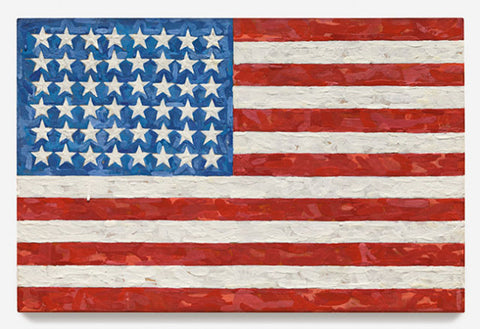
Flag, Jasper Johns, 1954 3' 6" x 5' 1", encaustic
However, far from a modern method, encaustic was originally used as long ago as the first century BCE! Greek warriors, who covered their ships with melted wax to seal them and make them water tight, found that by working pigments into the wax they could cover their ships in threatening war paint.

One of the Fayum Funerary Portraits, from 1st Century AD Greece. Perhaps one of the most famous examples of ancient encaustic painting
Encaustic is also extremely durable the wax essentially protects any paint or decoration beneath in a thick shield, so it was a favored method in the early Renaissance.
Here at art elements we have several artists who love to work with encaustic including Pam Nichols, Virginia Parks and others. We have to admit we are a little bit although it might seem a bit opaque at first, in love with this medium.

Warrior, Pam Nichols, 8x8
Reception for "Recollections": James Frey Muses on Themes of Recent and Ancient Memory
Friday night brought with it the opening reception for our current show here at Art Elements. "Recollections" features the work of painter and wine maker James Frey.

Artist James Frey standing next to "Depot Bay" one of his stunning work from the current show.
In his gallery talk James, who also owns Trisaetum winery, shared what the title "Recollections" means to him. He discussed the extent to which memory plays a vital role in both his identity as a wine maker, and as a painter. He explained that to him, the word recollection refers to both recent memories and ancient ones. Each wine that he makes, he observed, contains within it his very vivid memories of the year of its vintage, the weather, the picking process, and the season in which the grapes were grown. The ancient memory refers to the way in which the soil that his vineyards are planted is ancient soil, that draws from what he termed a geological memory. The roots of his vineyard pull directly from this ancient earth and flavors each bottle of his wine. Frey pointed out that in many of the works from "Recollections" there is a horizontal line that breaks up the canvas at some point, as we can see in Recollection No. 4 for example

James Frey, Recollection No. 4
For Frey, this line makes reference to the two layers of memory, the recent and the ancient, that informed the painting process as he worked.
His vineyards impact Frey's painting in more literal ways as well. In many of the works in "Recollections" the artist actually incorporated Pinot skins and soil from his vineyards directly into the canvas. These are part of what create the wonderful depth and texture evident in his work. It also brings his two worlds together in a lovely way.

Frey during his artist talk at the "Recollections" opening. Here the artist is sharing that one of his wines has been selected to be poured by the Obama's at a White House state dinner in the very near future. Congratulations James!
It was lovely to hear the public's response to James' work has he eloquently shared his inspiration at the opening last night. Art Elements has been fortunate enough to feature his work every two years since the opening of the gallery and it is always an absolute pleasure.
The show is now open and will run through June 18th. Stop by Art Elements and check it out!
"Recollections" Featuring the Work of James Frey Opens Today
Art Elements is thrilled to announce the opening of our new show - Recollections
featuring the abstract paintings of artist James Frey.

Recollections No. 3 by James Frey, 48x48"
Recollections will be open from April 21st - June 18th with an opening reception on the evening of April 29th from 5-7 pm
A little more about the artist:
James Frey began taking and developing his own photos at the age of 12. Three years later, he had begun working as a newspaper photojournalist and by the age of 16 became, at the time, the youngest recipient to receive an award from the California newspaper association for his work. He continued to work as a photojournalist in order to pay his way through college at the University of California, Berkeley and then later in graduate school at the University of Arizona.
In his late twenties, Frey turned to painting and developed a passion for abstract expressionist works. His paintings of rich, deep hues and vibrant contrasts create a powerful sense of color, shape and energy. In order to create a greater tactile quality, at times Frey will even incorporate vine cuttings and vineyard soils into a piece.

Recollections No. 6, James Frey, 48x36"
Frey's works are heavily influenced by his other passion, owner and winemaker for Trisaetum Winery. Whether it's the elements that create exceptional vineyards, or the kinetic energy of crush, Frey's works are clearly inspired by what goes on in the vineyard and in the winery.
Frey's studio is adjunct to his home on his family's Coast Range vineyard, where he lives with his wife Andrea, son Tristen, and daughter Tatum. His paintings and photography have been published and purchased by collectors and corporations throughout the world.
you can see the other works from Recollections at:
http://www.artelementsgallery.com/search?type=product&q=james+frey
Digging In: The Time Honored Practice of Pit Fired Pottery
Here at Art Elements we are lucky to feature the work of several AMAZING ceramic artists. Many of them practice what has been termed “alternative firing methods.” Essentially, this means that they use something other than a traditional gas or electric kiln (the type of kiln you probably saw if you took ceramics in high school) to fire their pottery and sculptures. For these potters, the firing process is a fundamental step in their art making that has a huge impact on the look of the finished pieces. These methods are often more physically demanding or time consuming that traditional firing practice, but the results they yield are amazing.
Easily the most ancient and time honored of these “alternative” firing methods is called “pit firing.” Practiced as early as 25,000 BCE, most potters think of pit firing as the original method of firing or “baking” clay into its hard finished form. The Greeks and Romans, as well as the ancient peoples of North America practiced pit firing. Basically anywhere that you can find a long-standing ceramic tradition, there is a history of pit firing.

Ancient Aztec Pit-Fired Vessel
Just as the name suggests, pit firing involves digging a out a pit in the ground (usually 2-2½ ft deep depending on how large your pieces are and how many you are firing), laying your clay pieces in the pit, covering them with combustible material, setting it ablaze and then allowing the fire to slowly burn down over the course of several hours.

Schematic of a pit firing http://www.alexmandli.com/process/pit-firing.html

http://ballclaystudio.com/how-to-pit-fire-pottery-without-a-kiln/
Like baking in the kitchen, in order to fire pottery, the clay must reach a specific temperature in order to vitrify or become hard. Throughout this process the clay becomes porous and soft, like rubber, anything that comes near it will stick to its surface. This also means that the clay will absorb any chemicals or fumes that pass over it during the firing process. This means that in pit firing, the ash and smoke created by whatever you have used to fuel your fire (wood, grass, leaves, even buffalo chips) will have an impact on the final colors and look of the piece. It is the fire itself that creates the color in a pit-fired work.

https://uclagettyprogram.files.wordpress.com/2009/11/pit-firing09-4.jpg
This means that no two pit fired pieces will ever look exactly the same, and that to some extent the process is rather unpredictable. However, experienced ceramicists can also manipulate the colors of their pit-fired art works by adding other chemical elements to the fire. This can by done by covering the individual pieces with specific compounds like copper carbonate, or it could be achieved by adding elements to the fire itself. Items like tea bags, banana peels, and animal bones will all create different color affects on a finished piece. A great example of this is evident in Mark Terry’s figurative sculpture entitled “Ariadne” – the bright oranges and greens dusted across the figure were created by this kind of experimentation with different chemicals in the fire. As you can see it can have some pretty amazing results. This allows the potter to play scientist, artist and pyromaniac all at once.

(Mark Terry “Ariadne”)
Once the fire has died, the finished ceramic pieces will have to be left under the ash and debris for several hours to cool. If they are unearthed too quickly the exposure to the cold air outside of the pit will cause them to crack. Once they are ready, the process of digging up the work and cleaning it off reveals all of the color and texture that the fire has left behind. It’s an exciting moment for the artist. Some pit-fired pottery is then waxed or polished to give it a sheen, further drawing out the depth of color created by the ash and soot.
Pit fired pottery has a distinctive look that is easy to identify once you are familiar with the technique.
Blythe Eastman’s pit fired animals provide a textbook example of the pit-fired aesthetic. The smokey grays, browns and blacks leave traces of the smoke and ash that licked across her little animals as the fire burned around them. It gives them a decidedly earthly feel, further associating her animals with nature, organic matter and the natural environment from which they are inspired.

(Blythe Eastman, “Rabbit Washing”)

(Blythe Eastman, “Horse”)
Another great example of pit-fired pottery is the work of Linda Workman-Morelli. Her work shows off the almost painterly affect that the fires traces leave behind on the surface of her work. Like Blythe, Linda creates objects that are evocative of the natural world. They make us think of stones, or shells. This is further enforced by the fact that she has polished them, almost like a stone at the bottom of the riverbed. The depth created by this polished look really shows off the natural color of her pit-fired pieces.
(Linda Workman-Morellia, untitled)
While pit firing is just one of many unique and interested alternative firing methods, its long history and rustic technique harkens back to the work of the first ancient potters, in a unique way. The pits that Linda, Blythe and Mark dig out to fire their pieces are no different from those dug by their ceramics ancestors. Both these contemporary artists and their predecessors return their clay pieces back to the earth from which they were created in order to finish and bring them to life. What is amazing to see is how truly modern this practice becomes in the hands of our talented potters.
Molly Reeves' Fantastsical Landscapes
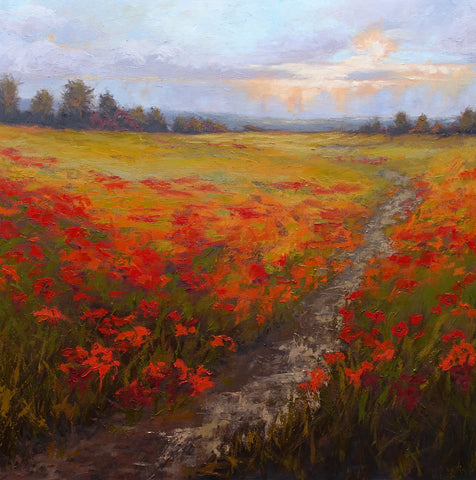
“Nothing can be beautiful which is not true.” – John Ruskin, 19th century art critic and theorist
A dense and vibrant wave of painterly poppies presses against the edge of the canvas in Molly Reeves’ painting “On Being,” – they beckon you to step on to the path that cuts through this patch of blossoms and enter into the artist’s world. The eye, obedient to Reeves visual instructions, then follows this winding trail toward the center of the canvas, and into the recesses of the landscape. Red petals melt into yellow field, which in turn roll toward a distant tree line that holds up an effervescent blue and purple sky dotted with cottony clouds.
While the intense reds and oranges of the poppy field in “On Being” overwhelm the eye at first, closer study of the painting reveals a beautifully composed and artfully balanced canvas. The soft cool tones and smooth texture of the skyline balances the heat and intensity of the flowers at the foreground. The result is a landscape painting that is simultaneously energizing and soothing a – a work that excites and calms the eye all at once. The yellows and greens at the midline of the canvas, coupled with the gentle curve of the path as it retreats into the field, create a clear sightline for the eye to follow, leading you on a visual journey through each poetic element that Reeves has selected for this work. Like beats in a song, or stanzas in a sonnet, these separate moments come together to create an over all sense of mood as well as of place, and invite you, the viewer, to join her there.
This is no accident. Nor is it an example the good fortune of finding an excellent subject to paint. Rather, it is evidence of overall Reeves’ approach to her art making. As she eloquently puts it…
“For me it is all about intention; examples might be: what kind of story do I want to tell, or where do I want to take the viewer. Long before I pick up the brush I am constantly observing different aspects of reality and mining my memory, quite naturally the two become fused. My desire through this reconciliation of observed reality and related memories is to create a two dimensional fiction that authentically tells a deeper and more thoughtful truth.” – Molly Reeves
(Reeves shows off her painting "Water Magic" on a visit that Art Elements owner Loni Parrish and gallery manager Sarah Askin made to her studio) Photo Credit: Sarah Askin
Reeves she makes clear that her landscape paintings reference elements of the natural world, but are in fact constructions – a pastiche of real and imagined (or remembered) imagery that she carefully combines in order to create a final composition. With this approach, she hopes to touch on deeper, perhaps more eternal truths than a simply record of the natural world. Ideas of play, invention and whimsy are all important components of Reeves work, which, although perhaps it is subtle at first, becomes more and more clear the more time you spend with her paintings.
This idea that the artist creates their own reality in order to touch upon inner truths, is drawn from a long standing belief that the arts reveal inner, fundamental truths -- that truth and beauty are inextricably related, and that in creating something truly beautiful, an essential truth is revealed. The belief that recording the truth is more complicated than merely copying what you see in life is fundamental here. This art philosophy, espoused by many of the Romantic painters of the 18th and 19th century, is linked to the notion that to see true beauty, either in art or in the natural world has an elevating affect and will literally improve the life of the viewer. For the art theorist John Ruskin (quoted above) beauty was truth, and visa versa. Reeves paintings are a wonderful example of this idea in play.
Another example of this notion of play, invention and whimsy is readily evident in her “Bird with Balls” series, which, along with several of her landscapes will be featured in our forthcoming “Flora and Fauna” show along with ceramic animal sculptor, Blythe Eastman.
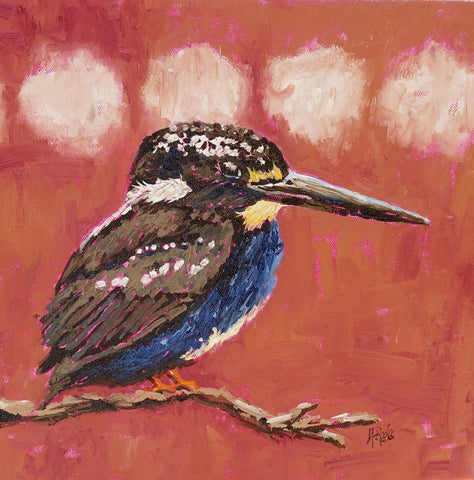
“Wise One” is a perfect example of Reeves whimsical approach. The incredibly skilful and naturalistically portrayed bird (as well as the tree branch upon which it sits) are juxtaposed with the fanciful pink and red hues of the sky as well as the “ball” shaped clouds that are aligned in a perfect little row. The symmetry of the clouds, something we never would see in the natural world, is a clear signal to the viewer that we have, once again, entered into Molly’s world.
Reeves intends for these paintings to inspire pure joy for the viewer. While she certainly could have chosen to represent these birds in a more “realistic” setting, as she likely saw them in nature, the choice to reposition them in this imagined setting adds a sense of play to the image that makes it something else entirely. But more than just fun, works like Molly Reeves can teach us something valuable about beauty and truth that can be found no where else in the world. They show us not only the inner truth and beauty of the artist, but hopefully, some inner truths about ourselves.
SMALL BUSINESS SATURDAY
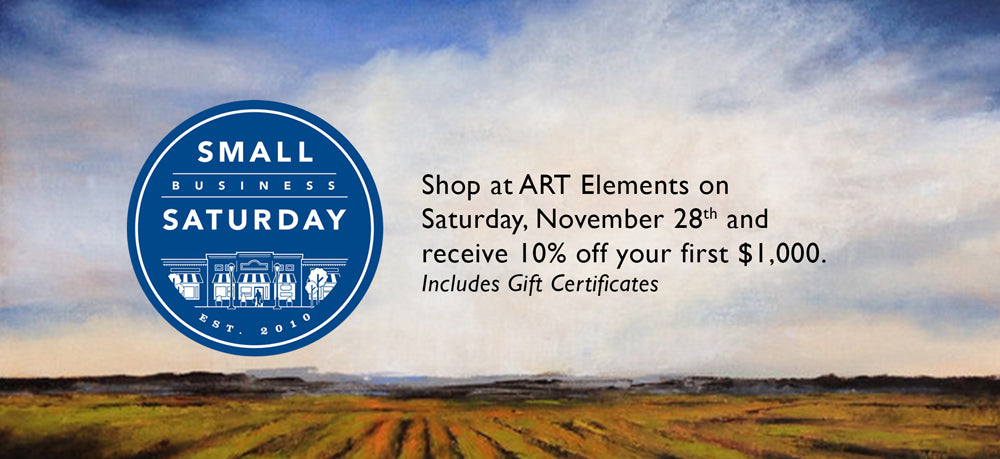
SELFIE PORTRAITS
Ditch your camera and phone, create yourselfie!
Instructions on how to make your own selfie portrait and enter to win an art supply basket.
View full article →






